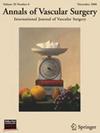Complete Endovascular Repair of Entire Aorta for Extensive Pathologies — A Set of China Strategies
IF 1.4
4区 医学
Q3 PERIPHERAL VASCULAR DISEASE
引用次数: 0
Abstract
Background
Endovascular aortic repair was introduced in China in 1997, with domestically produced devices emerging post-2000. Despite progress, treatment of complex aortic pathologies remains limited, necessitating innovative endovascular solutions.
Methods
Our center developed 8 off-the-shelf endovascular innovations, including 3 inner branch stent graft systems for aortic arch reconstruction, 2 branched/fenestrated stent grafts for thoracoabdominal and juxtarenal aortic aneurysms, 1 iliac branch device for internal iliac artery preservation, and 2 novel devices—EndoPatch and EndoSeal (Endonom Medtech)—designed to seal distal tears and occlude false lumen in aortic dissections. These advancements integrate technologies such as steerable delivery systems, preloaded navigation aids, and mixed or inner branch configurations to accommodate anatomical variations.
Results
Preliminary clinical applications demonstrated promising technical success rates and acceptable complication profiles. Two devices have been approved by China’s National Medical Products Administration for clinical use, while others remain under investigation. Key challenges include anatomical variability, branch vessel patency concerns, and the absence of long-term outcomes for most devices.
Conclusion
These innovations establish a comprehensive endovascular strategy for extensive aortic pathologies, addressing critical gaps in China’s device landscape. Early outcomes demonstrate the feasibility of standardized off-the-shelf solutions for complex anatomies, though multicenter trials and long-term follow-up remain essential to confirm safety and efficacy.
广泛病变的全主动脉血管内完全修复——一套中国策略。
血管内主动脉修复术于1997年首次在中国临床应用。在随后的几年里,这项技术在全国范围内迅速采用,并随着设备的不断发展而发展。2000年以后,得益于材料和制造工艺的进步,国产血管内装置开始出现,并不断发展壮大。尽管如此,在中国,用于治疗复杂主动脉病变的设备仍然有限,这导致血管外科医生普遍使用由医生修改的设备。近二十年来,我们中心一直致力于推进血管内技术治疗主动脉疾病。我们为主动脉弓分支、内脏动脉和髂内动脉的重建设计了创新的装置,特别是胸腹主动脉瘤夹层后的重建装置。目前,我们已经开发出一种支架移植系统,可用于主动脉扩张性疾病高危患者的全主动脉血管内修复。本文旨在讨论这些新型设备的设计原则,临床试验或应用的进展,以及在开发过程中遇到的技术挑战。
本文章由计算机程序翻译,如有差异,请以英文原文为准。
求助全文
约1分钟内获得全文
求助全文
来源期刊
CiteScore
3.00
自引率
13.30%
发文量
603
审稿时长
50 days
期刊介绍:
Annals of Vascular Surgery, published eight times a year, invites original manuscripts reporting clinical and experimental work in vascular surgery for peer review. Articles may be submitted for the following sections of the journal:
Clinical Research (reports of clinical series, new drug or medical device trials)
Basic Science Research (new investigations, experimental work)
Case Reports (reports on a limited series of patients)
General Reviews (scholarly review of the existing literature on a relevant topic)
Developments in Endovascular and Endoscopic Surgery
Selected Techniques (technical maneuvers)
Historical Notes (interesting vignettes from the early days of vascular surgery)
Editorials/Correspondence

 求助内容:
求助内容: 应助结果提醒方式:
应助结果提醒方式:


